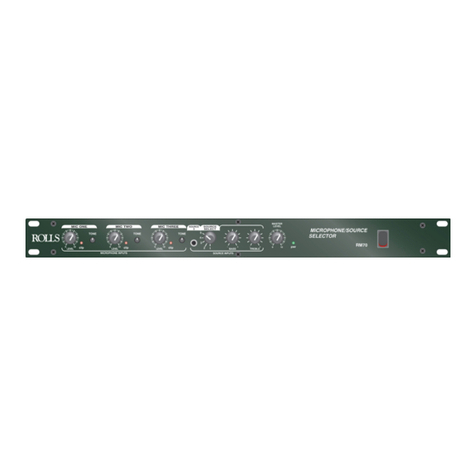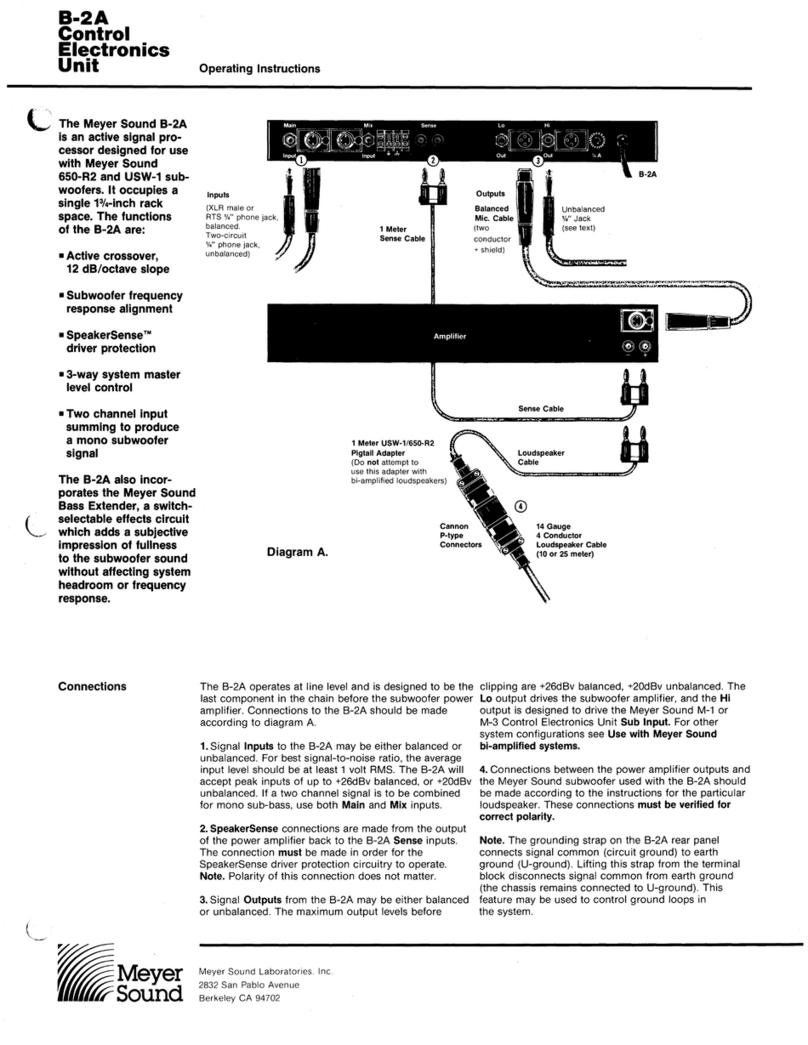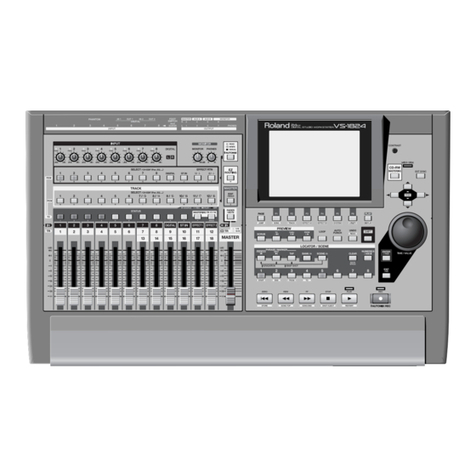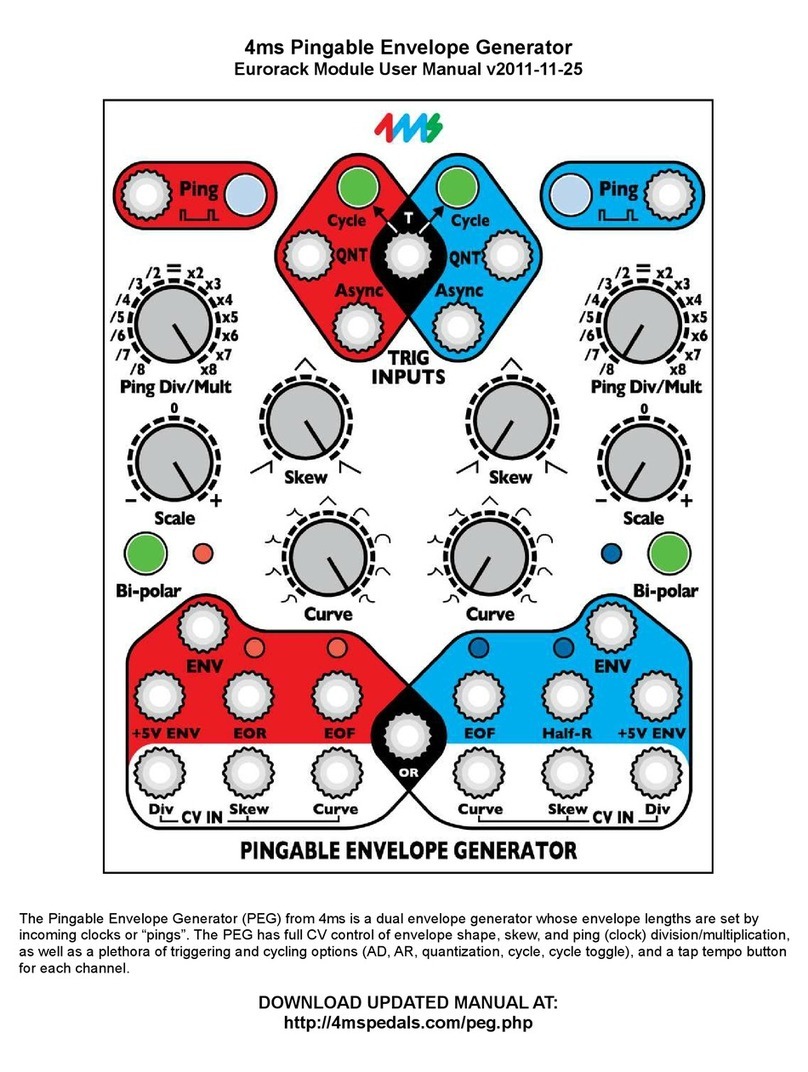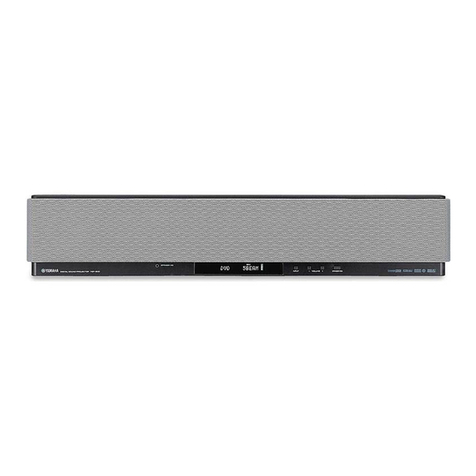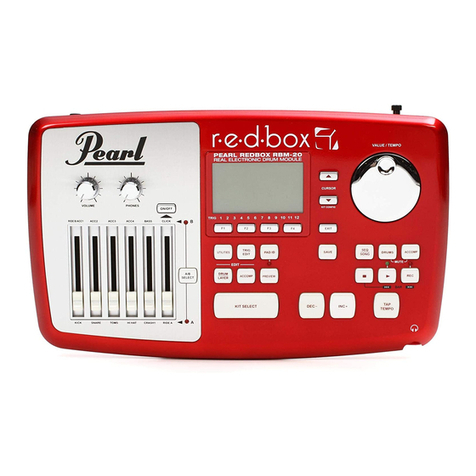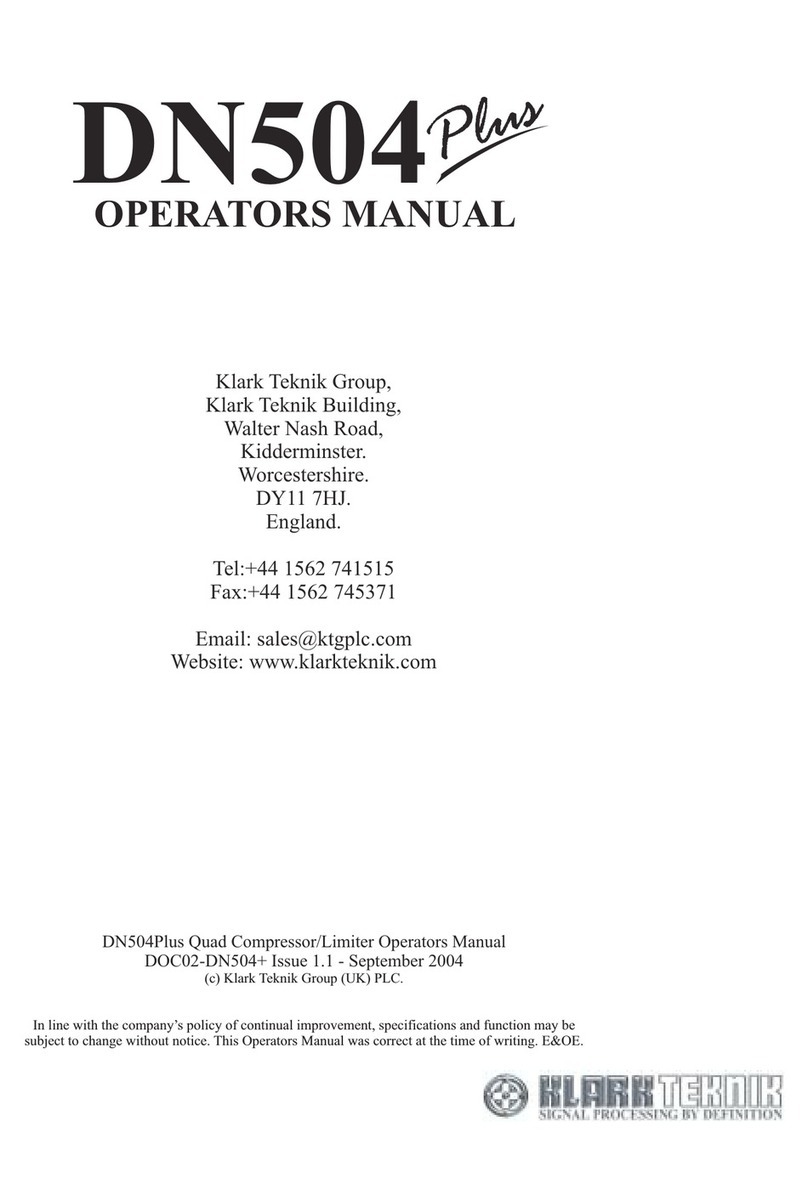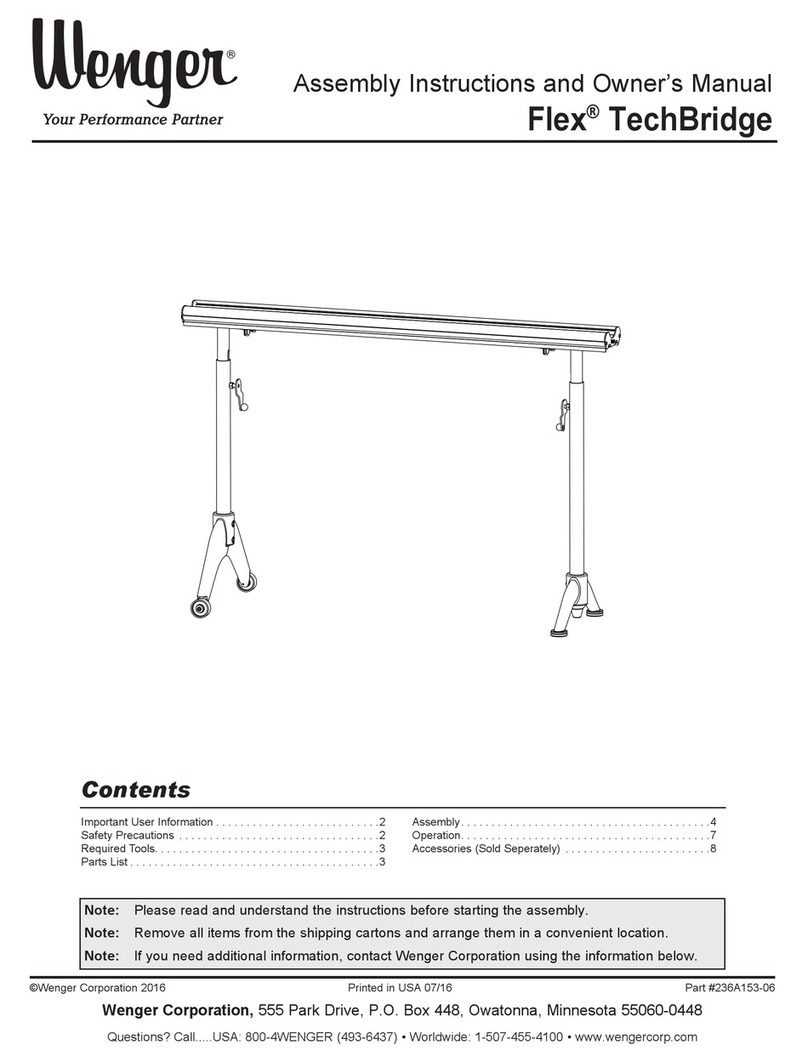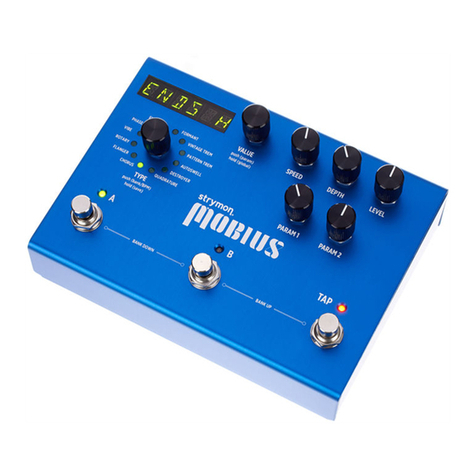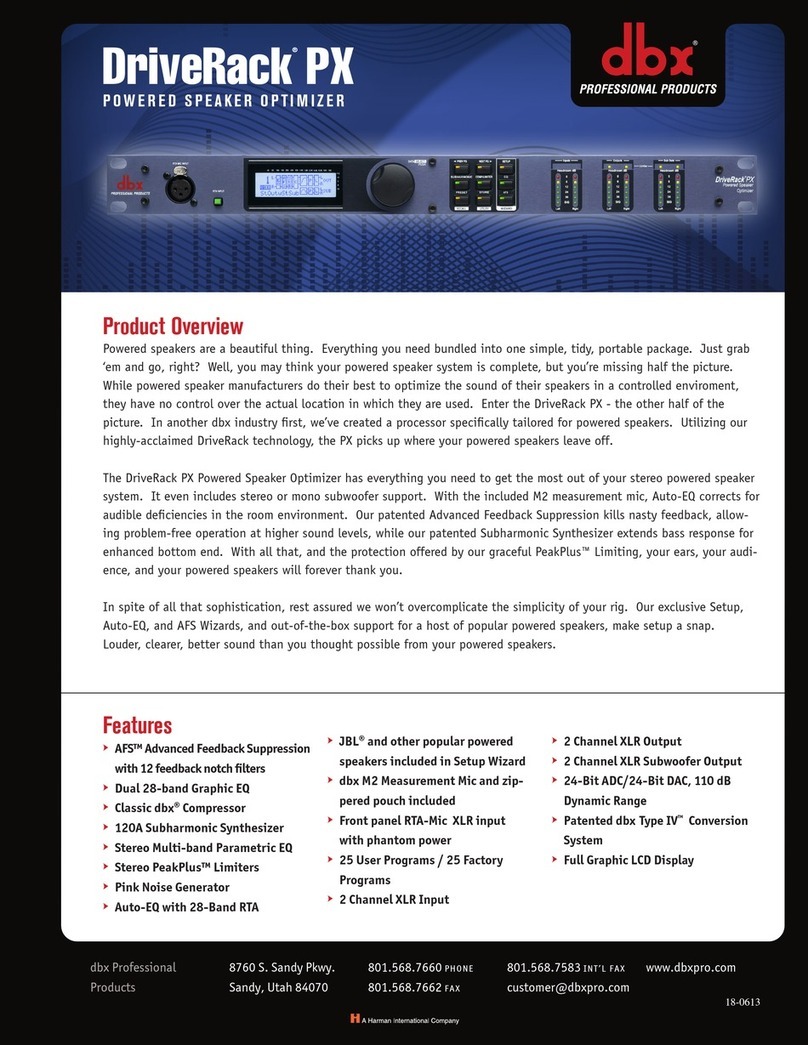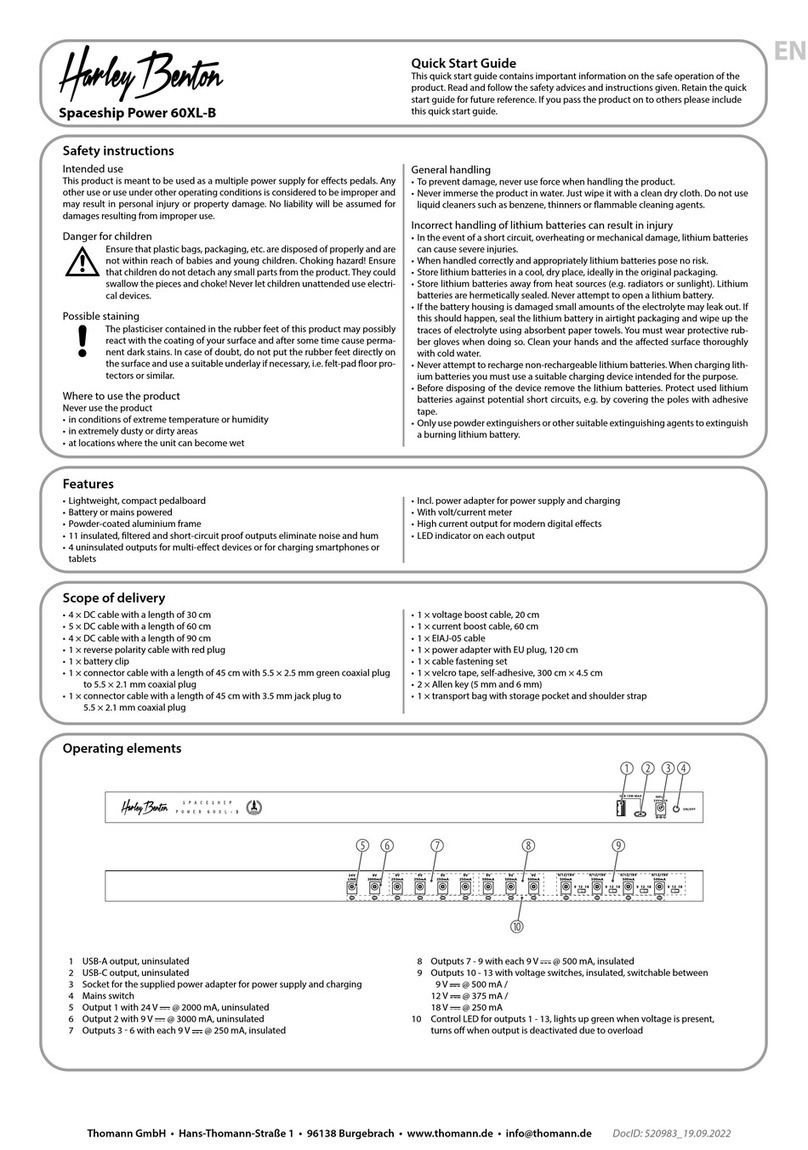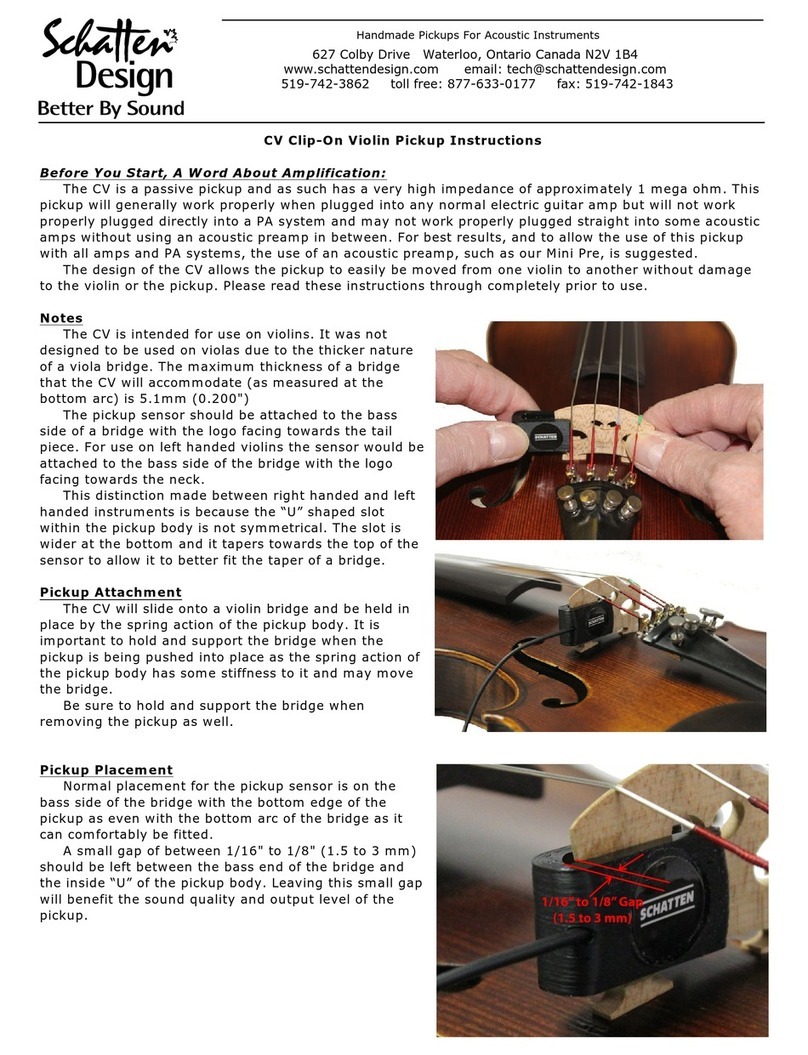Digital Audio Corporation MicroDAC IV User manual

MicroDAC IV
PORTABLE
PROGRAMMABLE
DIGITAL
FILTER
USER’S MANUAL
DIGITAL AUDIO CORPORATION
A DRI COMPANY


MicroDAC IV
PORTABLE PROGRAMMABLE DIGITAL
FILTER
User’s Manual
October 27, 1999
Document Number 990395
DIGITAL AUDIO CORPORATION
A DRI Company
5121 Holly Ridge Drive
Raleigh, NC 27612
Phone: 919 782 6767
Fax: 919 782 6766
www.digitalaudiocompany.com
Copyright © 1999 by Digital Audio Corporation.
All rights reserved.


5
TABLE OF CONTENTS
1.0 OVERVIEW ...............................................................................................................9
1.1 Introduction............................................................................................................9
2.0 Minimum Hardware Requirements ......................................................................10
2.0 OPERATION............................................................................................................11
2.1 Controls and Connectors.....................................................................................11
2.2 Fast Start.............................................................................................................13
3.0 STANDARD FILTER CONFIGURATIONS ..............................................................15
3.1 Selecting the Correct Filter Mode........................................................................15
3.2 Hints For Effectively Using The MicroDAC IV’s Filtering Capabilities.................15
3.3 Factory Preset Filter Descriptions.......................................................................16
3.4 Programmable Filter Descriptions.......................................................................20
5.0 CALIBRATION AND SERVICE................................................................................23
6.0 MICRODAC IV SPECIFICATIONS ..........................................................................25
6.1 Analog.................................................................................................................25
6.2 Digital ..................................................................................................................25
6.3 Construction........................................................................................................25

6

7
LIST OF FIGURES AND TABLES
Figure 1: MicroDAC IV Panels.......................................................................................11
Figure 2: Basic Enhancement Setup .............................................................................13
Figure 3: 1CH MODE Block Diagram............................................................................13
Figure 4: 2CH MODE Block Diagram............................................................................13
Figure 5: 1CH ST MODE Block Diagram.......................................................................19
Table 1: MicroDAC IV Input Connections......................................................................13
Table 2: 1CH MODE First Stage Factory Presets .........................................................16
Table 3: 1CH MODE Second Stage Factory Presets....................................................17
Table 4: 2CH MODE First Stage Factory Presets .........................................................18
Table 5: 2CH MODE Second Stage Factory Presets....................................................18
Table 6: 1CH•ST MODE Factory Presets......................................................................19
Table 7: Programmable MODE A Factory Presets........................................................20
Table 8: Programmable MODE B Factory Presets........................................................20
Table 9: Programmable MODE C Factory Presets........................................................21
Table 10: Programmable MODE D Factory Presets......................................................21

8

9
1.0 OVERVIEW
1.1 Introduction
The MicroDAC IV is a portable, programmable digital filter targeted for applications requiring
unattended filter deployment. A replacement for the venerable MicroDAC III, this powerful
signal processor is fully self-contained and features:
•Easy setup and operation
•Operation with live voice signals, cassette and microcassette tape recorders, video cassette
recorders, telephone taps, and radio receivers
•12VDC power input enables operation from AC power (external adaptor included) or from
12V automotive battery system
•Compact enclosure (1.5” H x 7.3”W x 10.0”D)
•Fixed bandwidth of 5.4kHz
•Three factory preset adaptive filtering modes
•Four programmable filtering modes
Key Features
•Stereo processing capability, in addition to standard monaural
•Windowsprogramming software, which allows easy, intuitive reprogramming of filters for
specific applications
•Crash Detect, which will automatically clear the adaptive filter should it crash
•Reference Compensation, which automatically adjusts the RIGHT (REF) input level as
necessary to avoid coefficient saturation and maintain optimum cancellation
•Auto Mu, which maintains adaptive filter stability by automatically scaling adapt rate for both
input signal power and filter size
•Both standard LMS (Least Mean Square) and LAV (Least Absolute Value) adaptation
algorithms available
•EXTERNAL CLEAR connector, which allows manual clearing of the adaptive filter by remote
switch closure
•Dynamically partitionable filter array, which allows combining large and small filters in series
•Input Limiter, which automatically reduces input levels on overload
•AGC, which automatically boosts level of processed signal prior to output
•Digital Output (S/PDIF format) for recording directly to DAT

10
2.0 Minimum Hardware Requirements
NOTE: Computer is required only for programming the MicroDAC IV; it is not required for stand-
alone operation.
•100 MHz CPU (Pentium or equivalent)
•Windows95/98/NT operating system
•8 Megabytes of RAM
•At least 4 Megabytes spare hard disk space
•640x480 color VGA display
•Two button mouse
•At least one spare RS232 port

11
2.0 OPERATION
MicroDAC IV promotes ease-of-use by reducing the number of buttons and switches the user
needs to learn. All of the settings that required adjusting internal DIP switches in the previous
version can now be accomplished using a computer. The user configures the filter(s) as
desired using special Windows software, then downloads the settings to the MicroDAC IV
where they are stored in non-volatile memory.
The following section discusses the connections and controls for the unit. The remaining sections
describe typical setups and provide an overview of adaptive filters to ease the selection of the best
filter in a particular situation.
2.1 Controls and Connectors
Figure 1: MicroDAC IV Panels
Refer to Figure 1 for an illustration of the front panel features, described as follows:
•Standard 1/8” stereo headphones may be plugged into the PHONES connector. Adjust
loudness with the VOLUME control beside the connector.
•The green POWER LED indicates that the MicroDAC IV is operating.
•The green ADAPT LED indicates that an adaptive filter is continuously updating its filter
solution.
•The green PANEL LOCKED LED indicates that one or more of the front panel controls is
locked and can only be changed by the Windows software.

12
•The INPUT LEVEL rotary knobs adjust the input signal levels on the LEFT (PRI) and RIGHT
(REF) channels. Above each knob is a tricolor Level LED that indicates input signal
strength. Adjust the LEFT and RIGHT INPUT controls so that the tricolor LEVEL LEDs
display green or occasionally yellow. Do not allow the input level to go into the red region or
distortion may occur.
•The CLEAR button is used to restart the adaptive filters as deemed necessary. This function is
particularly useful if the filter has “crashed” and produces only garbled noise on its outputs (an
extremely rare event when the Crash Detect feature is enabled). Another example of when to
press the CLEAR switch is when the audio scene changes suddenly, requiring a new filter
solution; this may occur when the microphone is moved, or when processing tape recorded
conversations that occurred at different locations.
•The MODE rotary switch selects the desired filter by rotating the knob to the desired filter.
The MicroDAC IV will automatically reset and load the filter whenever the MODE setting is
changed. Notice that one of the filter settings is labeled BYPASS; this setting simply routes
the input signal to the output without any processing.
Now refer to the Figure 1illustration of the rear panel features, described as follows:
•The POWER connector mates to a 2.1 mm barrel plug. To power the unit connect the external
AC power adapter to the POWER connector. Alternatively, 12VDC power can be directly applied
using a specially-wired adaptor; the wiring guide for the plug is silk-screened on the rear panel.
•The MicroDAC IV communicates with the computer’s serial port via the RS232 connector. The
supplied Windows software programs the MicroDAC IV over this serial link.
•An EXTERNAL CLEAR jack can be used to remotely clear the adaptive filters via contact
closure (shorting the two terminals together). This operates in an identical manner to the front
panel CLEAR button.
•The 44.1KHz DIGITAL OUTPUT is an S/PDIF format digital data stream that is driven
directly from the signal processor output. This data is clocked at the same rate as CD
players, which allows the digital processed signal to be recorded directly to a DAT or CD
recorder.
•The ANALOG OUTPUT RCA jacks provide the MicroDAC IV’s filtered output in analog form.
These line level signals can be directly connected to a copying tape recorder or loud speaker
amplifier, if desired. If the MicroDAC IV is not powered, the ANALOG INPUT signals are
automatically routed to the ANALOG OUTPUT jacks.
•The ANALOG INPUT RCA jacks are the MicroDAC IV’s inputs. These line level inputs allow
the audio source to be input for filtering.

13
2.2 Fast Start
Figure 2: Basic Enhancement Setup
Fast start the MicroDAC IV as follows using Figure 2 as a guide:
1. Connect the audio source(s) to the LEFT (PRI) and RIGHT (REF) ANALOG INPUT RCA jacks
on the MicroDAC IV rear panel as shown in Table 1. Although this table assumes a live
microphone preamp connected to the input of the MicroDAC IV, the signal could come from
many types of sources such as a cassette or micro-cassette recorder, DAT recorder,
videocassette recorder, telephone tap, or radio receiver. Note that the RIGHT (REF) signal is
only used in stereo configuration and/or with the 2CH Adaptive filter.
Table 1: MicroDAC IV Input Connections
MODE LEFT (PRI) Input RIGHT (REF) Input
1CH Preamp output Unused
2CH Preamp output TV/radio output
1CH STereo Left preamp output Right preamp
output
A-D (Mono
configurations) Preamp output
TV/radio output, if
2CH Adaptive filter
programmed;
unused otherwise
A-D (Stereo
configurations) Left preamp output Right preamp
output
2. If you wish to record the enhanced audio, connect the line-level audio inputs (TAPE IN jacks) of
your Enhanced Tape Recorder to the LEFT and RIGHT ANALOG OUTPUT jacks on the
MicroDAC IV rear panel as shown. Alternatively, the digital output stream may be directly
recorded by connecting the 44.1KHz DIGITAL OUTPUT to the digital input of the DAT
recorder.
3. Turn the phones VOLUME control to MIN, then connect the stereo headphones to the PHONES
jack.
4. Rotate both INPUT LEVEL knobs located on the front panel fully counter-clockwise and power
the MicroDAC IV on. Switch the front panel MODE switch to BYPASS, so the signal input will
flow directly to the output without being altered. As the source audio (live or recorded) plays,
adjust the front panel INPUT LEVEL knobs clockwise until the tricolor INPUT LEVEL LEDs flash

14
green. If these LEDs flash in the red color region, then the knob has been turned too far; reduce
the corresponding INPUT LEVEL knob setting. Now adjust the PHONES knob to a comfortable
listening level.
NOTE: If the 2CH Adaptive filter is used, it is recommended that the RIGHT (REF) input be set to
a slightly higher level than the LEFT (PRI) input to ensure maximum cancellation.
5. Rotate the MODE switch to the desired filter position.
6. Start the recorder if necessary, and monitor the recording to ensure quality.

15
3.0 STANDARD FILTER CONFIGURATIONS
3.1 Selecting the Correct Filter Mode
The filters in the standard MicroDAC IV are optimized for noise cancellation to increase voice
intelligibility. Simple noises (e.g., tones, hum) are generally greatly attenuated. However, more
complex noises (e.g., ambient restaurant noise, bar noise) may not be as effectively attenuated, but
should be somewhat reduced.
The MODE switch setting determines the type of filtering based upon the configuration programmed
into the MicroDAC IV. When in the BYPASS mode, the MicroDAC IV simply transmits any audio
applied to the ANALOG INPUT connector directly through to the ANALOG OUTPUT connector,
bypassing the audio filters.
The three standard filter configurations correspond to the first three positions of the MODE switch;
the remaining positions are programmable by the Windows software. The standard filters are one-
channel mono (1CH), two-channel mono (2CH), amd one-channel stereo (1CH•ST).
The 1CH filter does an excellent job of reducing simple time-correlated noises, such as tones, hums,
and buzzes from a monaural signal. It also does an excellent job of reducing echoes and
reverberations. Similarly, the 1CH•ST filter removes tones, hums, buzzes, and echoes from a stereo
signal, except that the filters’ capability is spread across two signals, versus just one in the 1CH
case.
The 2CH filter is used primarily for live radio/TV removal. If the incoming audio from a microphone is
corrupted by interfering audio from a radio or television, a second radio/TV tuned to the same
channel can be used as a cancellation reference for reducing the interfering audio and revealing the
desired conversation. Simply connect the audio output from the second radio/TV to the RIGHT
(REF) input, adjust the levels, and the cancellation will be performed automatically.
3.2 Hints For Effectively Using The MicroDAC IV’s Filtering Capabilities
First, it is vital that the microphone installation and/or source material be prepared as carefully
as possible. For example, if the source audio is from a tape recorder and the microphone was
placed beside a loud air conditioner and the target voices are 40 feet away, it is doubtful any
recoverable voice was recorded onto the tape, especially if the recorder used an automatic
level control mechanism (While this sounds like an unusual example, it does happen
frequently.) Also, make sure the heads are clean and properly aligned on the playback
machine, to allow maximum recorded signal to be available to the signal processor.
Second, keep the input levels in the green to yellow zone at all times. Increasing the input level
into the red zone could create distortion that will hinder the MicroDAC IV’s filtering capabilities.
Third, if the filtered output of the MicroDAC IV is to be recorded, make sure that the recording
machine’s heads are clean and that the mechanism is properly lubricated and in good working
order.

16
Finally, always use good quality, fresh tapes for all recordings, and if possible, monitor the
recording as it is being made.
3.3 Factory Preset Filter Descriptions
1CH MODE:
Notice that in 1CH MODE, only the LEFT (PRI) input gets processed. This signal is first fed through
the Limiter, which helps prevent the signal from distorting on overload.
The signal then enters the first stage 1CH Adaptive filter, which is configured as follows:
Table 2: 1CH MODE First Stage Factory Presets
Parameter Preset Value
Filter Size 1024 taps
Prediction Span Delay 2 samples
Adapt Rate 8
Adapt Mode Auto
Output Residue
Algorithm LMS
Crash Detect Enabled
After the first stage of filtering, the signal enters the second stage 1CH Adaptive filter, which is
configured as follows:
Figure 3: 1CH MODE Block Diagram

17
Table 3: 1CH MODE Second Stage Factory Presets
Parameter Preset Value
Filter Size 512 taps
Prediction Span Delay 2 samples
Adapt Rate 32
Adapt Mode Auto
Output Residue
Algorithm LMS
Crash Detect Enabled
Next, the signal is 200Hz Highpass filtered, to remove any low frequency noises that may remain
after processing, and 3200Hz Lowpass filtered to remove high frequency hiss.
Finally, a 10dB AGC is applied to correct for near party / far party talkers, and to provide a good
output level for recording.
2CH MODE:
Notice that in 2CH MODE, both the LEFT (PRI) and RIGHT (REF) inputs get fed into the processor.
The LEFT (PRI) input is the signal from which interfering audio is to be removed, usually originating
Figure 4: 2CH MODE Block Diagram

18
from a concealed microphone that has interfering radio/TV audio. The RIGHT (REF) input is the
noise reference, usually the audio output from a second radio/TV tuned to the same channel.
The signals are first fed through the stereo Limiter, which helps prevent the signals from distorting
on overload. The Limiter internally “links” the two channels, such that an overload on either input
channel will cause the levels to be reduced equally on both channels. This minimizes the impact on
the 2CH Adaptive filter solution.
The limited signals then enter the first stage 2CH Adaptive filter, which is configured as follows:
Table 4: 2CH MODE First Stage Factory Presets
Parameter Preset Value
Filter Size 3472 taps
Delay Channel Input (Primary)
Delay 100 samples
Adapt Rate 16
Adapt Mode Auto
Output Residue
Algorithm LMS
Reference Compensation Enabled
Crash Detect Enabled
After the first stage of filtering, the signal enters the second stage 1CH Adaptive filter, which is
configured as follows:
Table 5: 2CH MODE Second Stage Factory Presets
Parameter Preset Value
Filter Size 128 taps
Prediction Span Delay 2 samples
Adapt Rate 32
Adapt Mode Auto
Output Residue
Algorithm LMS
Crash Detect Enabled
Next, the signal is 200Hz Highpass filtered, to remove any low frequency noises that may remain
after processing, and 3200Hz Lowpass filtered to remove high frequency hiss.
Finally, a 10dB AGC is applied to correct for near party / far party talkers, and to provide a good
output level for recording.

19
1CH•ST MODE:
Notice that in 1CH•ST MODE, both the LEFT (PRI) and RIGHT (REF) inputs get fed into the
processor. These are usually the stereo output signals from either a stereo microphone preamplifier
or a stereo body wire receiver.
The signals are first fed through the stereo Limiter, which helps prevent the signals from distorting
on overload. The Limiter internally “links” the two channels, such that an overload on either input
channel will cause the levels to be reduced equally on both channels. This maintains a proper stereo
effect on the two signals.
Each limited signal then enters its own 1CH Adaptive filter (two filters total). Each filter is configured
as follows:
Table 6: 1CH•ST MODE Factory Presets
Parameter Preset Value
Filter Size 1024 taps
Prediction Span Delay 2 samples
Adapt Rate 8
Adapt Mode Auto
Output Residue
Algorithm LMS
Crash DetectEnabled
Figure
5
: 1CH ST MODE Block Diagram

20
Next, the signal is 200Hz Highpass filtered, to remove any low frequency noises that may remain
after processing, and 3200Hz Lowpass filtered to remove high frequency hiss.
Finally, a 10dB AGC is applied to correct for near party / far party talkers, and to provide a good
output level for recording.
3.4 Programmable Filter Descriptions
Filter modes A-Dare factory preset as large, single 2CH Adaptive filters. Their settings are
listed in Tables 7-10. Please refer to the MicroDAC IV Portable Programmable Digital Filter
Configuration Software User’s Manual for complete details on programming filter modes A-D.
Table 7: Programmable MODE A Factory Presets
Parameter Preset Value
Limiter Disabled
Filter Size 3600 taps
Delay Channel Input (Primary)
Delay 100 samples
Adapt Rate 16
Adapt Mode Auto
Output Residue
Algorithm LMS
Reference Compensation Enabled
Crash Detect Enabled
200 Hz Highpass Filter Disabled
Lowpass Filter Disabled
AGC Disabled
Table 8: Programmable MODE B Factory Presets
Parameter Preset Value
Limiter Enabled
Filter Size 3600 taps
Delay Channel Input (Primary)
Delay 100 samples
Adapt Rate 16
Adapt Mode Auto
Output Residue
Algorithm LMS
Reference Compensation Enabled
Crash Detect Enabled
200 Hz Highpass FilterEnabled
Lowpass Filter Disabled
AGC Disabled
Table of contents
Other Digital Audio Corporation Music Equipment manuals

